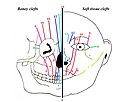Frontonasal dysplasia: Difference between revisions
CSV import Tags: mobile edit mobile web edit |
CSV import |
||
| Line 37: | Line 37: | ||
{{stub}} | {{stub}} | ||
{{dictionary-stub1}} | {{dictionary-stub1}} | ||
<gallery> | |||
File:Median_Cleft_Face_Syndrome_1.jpg|Frontonasal dysplasia | |||
File:Median_Cleft_Face_Syndrome_5.jpg|Frontonasal dysplasia | |||
File:Picture_Tessier_classification.jpg|Tessier classification of craniofacial clefts | |||
File:Gray44.png|Diagram of the human skull | |||
</gallery> | |||
Revision as of 04:39, 18 February 2025
Frontonasal dysplasia (FND), also known as Median cleft face syndrome, is a rare genetic disorder that affects the development of the head and face before birth. The condition is characterized by abnormalities that can affect the nose, eyes, and upper lip.
Symptoms and Signs
The most common features of frontonasal dysplasia are widely spaced eyes (hypertelorism), a broad nose, a slit (cleft) in one or both nostrils (bifid nose), and a cleft lip and palate. Other features can include a widow's peak hairline, a flat or absent nasal bridge, and skin-covered gaps in the bones of the forehead (anterior cranial fossa meningocele).
Causes
Frontonasal dysplasia is caused by mutations in the ALX3, ALX4, and ZSWIM6 genes. These genes provide instructions for making proteins that are involved in the development of tissues and organs before birth. Mutations in these genes disrupt the normal development of the head and face, leading to the features of frontonasal dysplasia.
Diagnosis
Diagnosis of frontonasal dysplasia is based on a clinical examination and confirmed by genetic testing. Imaging tests such as X-rays, CT scans, and MRI can also be used to assess the severity of the condition.
Treatment
Treatment for frontonasal dysplasia is symptomatic and supportive. It often involves surgery to correct the facial abnormalities. Other treatments may include speech therapy for those with a cleft palate and special education services for those with learning disabilities.
Prognosis
The prognosis for individuals with frontonasal dysplasia varies. Some individuals have normal intelligence and lead normal lives, while others may have learning disabilities and require special education services.
See also
References
<references />







